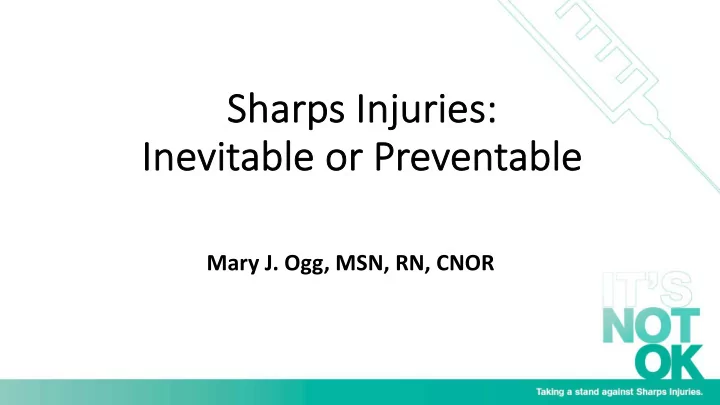

Sh Sharps s In Injuries: s: In Inevi vitable e or Preven entable Mary J. Ogg, MSN, RN, CNOR
Wh Why y is sharp rps safety ty import rtant? t? § 500,000 health care workers injured each year § Injuries associated with occupational transmission of HBV, HCV, & HIV § 132 documented cases of health care provider to patient transmission of HBV, HCV, or HIV
Distribution of sharps injuries among Massachusetts hospital workers by how the injury occurred, 2010-2015 Suturing Collision with worker or sharp Handle/Pass equipment Manipulate needle in patient During clean-up Improper disposal During sharps disposal Recap needle Activating sharps injury prevention feature Other Unknown / Not answered / Nonclassifiable 0 5 10 15 20 25 30
OS OSHA HA’s Blo loodborne Pathogen Standard 29CFR 1910.1030
Haz Hazar ard E Elim limin inatio tion Needle- Needleless free connectors injectors Alternative cutting devices
Engi Engine neering ng Controls Safety Scalpels Safety needles & syringes
Wo Work Practice Controls
Ad Admi ministrative Controls Exposure control Policies & plan procedures Education & Documentation competency
Pe Personal Protective Equipment
St Strategies to o Reduce Risks Blunt suture needles Alternative wound closure devices Neutral zone Situational awareness Double gloving
Sa Safety Features Simple Reliable Clear Easily understood
Pr Product Evaluat ation & Selection Frontline workers Multidisciplinary team Priorities Reducing sharps injuries
Se Selection on Cri riteri ria Patient safety User acceptance Worker safety Overall performance Efficiency
Sa Safety De Design Active Passive Integrated
Pr Product selection Frontline • Education • Training users • Correct use Survey • Criteria tool • Measurements • Data Selection analysis
Cos Cost analysis Cost of the product Potential cost savings Education & training costs
Assessme As ment Performance Injury Usage Acceptance Correct rates rate usage
Efficacy of current devices Annual Evaluation •Reducing injuries •Preventing injuries New device evaluation •Persistent sharps injuries
Obstacles 55% 52 % 32% 29% Lack of Availability of Lack of Training empowerment conventional support sharps
Obstacles 27 % 15 % 24% Budget Lack of safety Lack of culture management support
Un Under er-re reporting of injuries Perceived low risk Lack of time; inconvenient Fear of reprisal
Inc Increa easing ing Repo eporting ting Education Convenience
Culture of Safety
Cr Creating a Cu Culture of of Safety Patient & worker safety Worker participation Availability of safety devices, PPE Influence of group norms Socialization of new hires
Re Resources OSHA NIOSH Resources AORN ANA
AORN N Sharp arps Safety Tool ool Kit • Educational power points • Analysis of sharps injuries • Implementation plan • List of online resources • Evaluation of sharps safety • Sharps safety poster “how devices to” • Evidence-based Posters • Frequently Asked Questions
References 1. Aarnio P, Laine T. Glove perforation rate in vascular surgery--a comparison between single and double gloving. Vasa . 2001;30(2): 122- 124. 2. Bessinger CD Jr. Preventing transmission of human immunodeficiency virus during operations. Surg Gynecol Obstet . 1988;167(4): 287- 289. 3. Bush C, Schmid K, Rupp ME, et al. Bloodborne pathogen exposures: difference in reporting rates and individual predictors among health care personnel. AJIC.2017; 45: 373-376. 4. Coulthard P, Esposito M, Worthington HV, van der Elst M, van Waes OJ, Darcey J. Tissue adhesives for closure of surgical incisions. Cochrane Database Syst Rev. 2010;(5)(5):CD004287 5. Florman S, Burgdorf M, Finigan K, Slakey D, Hewitt R, Nichols RL. Efficacy of double gloving with an intrinsic indicator system. Surg Infect (Larchmt). 2005;6(4): 385-395. doi:10.1089/sur.2005.6.385. 6. Guideline for Sharps Safety. In: Guidelines for Perioperative Practice . Denver, CO: AORN, Inc; 2018:415-438. 7. Jagger J, Berguer R, Phillips EK, Parker G, Gomaa AE. Increase in sharps injuries in surgical settings versus nonsurgical settings after passage of national needlestick legislation. J Am Coll Surg . 2010;210(4): 496-502. doi:10.1016/j.jamcollsurg.2009.12.018. 8. Laine T, Aarnio P. How often does glove perforation occur in surgery? Comparison between single gloves and a double-gloving system. Am J Surg . 2001;181(6): 564-566. 9. Ly J, Mittal A, Windsor J. Systematic review and meta-analysis of cutting diathermy versus scalpel for skin incision. Br J Surg . 2012;99(5): 613-620. doi:10.1002/bjs.8708; 10.1002/bjs.8708. 10. Panlilio AL, Orelien JG, Srivastava PU, et al. Estimate of the annual number of percutaneous injuries among hospital-based healthcare workers in the United States, 1997-1998.. Infection Control & Hospital Epidemiology. 2004;25(7): 556-562. 11. Parantainen A, Verbeek JH, Lavoie MC, Pahwa M. Blunt versus sharp suture needles for preventing percutaneous exposure incidents in surgical staff. Cochrane Database Syst Rev. 2011;11:CD009170. 12. Tanner J, Parkinson H. Double gloving to reduce surgical cross-infection. Cochrane Database Syst Rev . 2009;3: CD003087. doi:10.1002/14651858.CD003087.pub2. 13. Weiss ES, Makary MA, Wang T, et al. Prevalence of blood-borne pathogens in an urban, university-based general surgical practice. Ann Surg . 2005;241(5): 803-7; discussion 807-9.
Resources 1. ANA Sharps Injury Prevention http://www.nursingworld.org/MainMenuCategories/WorkplaceSafety/Healthy-Work- Environment/SafeNeedles/ 2. AORN Sharps Safety Tool Kit https://www.aorn.org/guidelines/clinical-resources/tool-kits/sharps-safety-tool-kit 3. OSHA Healthcare Wide Hazards Needlestick/Sharps Injuries https://www.osha.gov/SLTC/etools/hospital/hazards/sharps/sharps.html 4. NIOSH STOP STICKS CAMPAIGN https://www.cdc.gov/niosh/stopsticks/sharpsinjuries.html
Recommend
More recommend